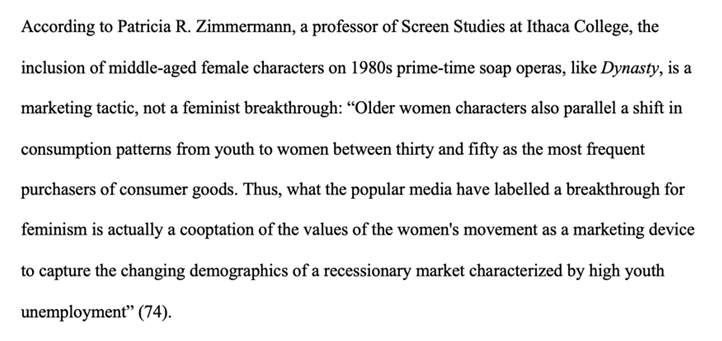3 Incorporating Quotes
-
-
- Introducing Quotes
- Punctuating Quotes
- Using a Colon
- Making the Quote Part of Your Own Sentence
- Quoting Quotes
- Quoting Dialogue
- Block Quotes
Introducing Quotes
Let’s begin by reviewing the importance of introducing quotations.
When you want to include a quote in your paper, you need to introduce it; you should never have a quote standing alone as a sentence. For example, you don’t want to do this:
Example
𝐈𝐧 𝙏𝙝𝙚 𝙎𝙚𝙫𝙚𝙣 𝙃𝙪𝙨𝙗𝙖𝙣𝙙𝙨 𝙤𝙛 𝙀𝙫𝙚𝙡𝙮𝙣 𝙃𝙪𝙜𝙤, 𝐄𝐯𝐞𝐥𝐲𝐧 𝐇𝐮𝐠𝐨’𝐬 𝐜𝐡𝐚𝐫𝐚𝐜𝐭𝐞𝐫 𝐮𝐧𝐝𝐞𝐫𝐠𝐨𝐞𝐬 𝐚 𝐜𝐨𝐬𝐦𝐞𝐭𝐢𝐜 𝐭𝐫𝐚𝐧𝐬𝐟𝐨𝐫𝐦𝐚𝐭𝐢𝐨𝐧. “𝐆𝐰𝐞𝐧 𝐛𝐥𝐞𝐚𝐜𝐡𝐞𝐝 𝐦𝐲 𝐡𝐚𝐢𝐫 𝐚𝐧𝐝 𝐜𝐮𝐭 𝐢𝐭 𝐢𝐧𝐭𝐨 𝐚 𝐬𝐡𝐨𝐮𝐥𝐝𝐞𝐫-𝐥𝐞𝐧𝐠𝐭𝐡 𝐛𝐨𝐛” (𝐉𝐞𝐧𝐤𝐢𝐧𝐬 𝐑𝐞𝐢𝐝 𝟓𝟎). 𝐓𝐡𝐞 𝐩𝐮𝐫𝐩𝐨𝐬𝐞 𝐨𝐟 𝐭𝐡𝐢𝐬 𝐭𝐫𝐚𝐧𝐬𝐟𝐨𝐫𝐦𝐚𝐭𝐢𝐨𝐧 𝐢𝐬 𝐭𝐨 𝐦𝐚𝐤𝐞 𝐄𝐯𝐞𝐥𝐲𝐧 𝐚𝐩𝐩𝐞𝐚𝐫 𝐥𝐞𝐬𝐬 𝐥𝐢𝐤𝐞 𝐚 𝐂𝐮𝐛𝐚𝐧 𝐰𝐨𝐦𝐚𝐧 𝐚𝐧𝐝 𝐦𝐨𝐫𝐞 𝐥𝐢𝐤𝐞 𝐚 𝐰𝐡𝐢𝐭𝐞 𝐰𝐨𝐦𝐚𝐧.As you can see, the quote is floating in the middle of the paragraph and thus appears out of place and disconnected from the surrounding sentences. We can fix this problem by integrating the quote into one of our own sentences. Using the same example, we could say:
Example
𝐈𝐧 𝙏𝙝𝙚 𝙎𝙚𝙫𝙚𝙣 𝙃𝙪𝙨𝙗𝙖𝙣𝙙𝙨 𝙤𝙛 𝙀𝙫𝙚𝙡𝙮𝙣 𝙃𝙪𝙜𝙤, 𝐄𝐯𝐞𝐥𝐲𝐧 𝐇𝐮𝐠𝐨’𝐬 𝐜𝐡𝐚𝐫𝐚𝐜𝐭𝐞𝐫 𝐮𝐧𝐝𝐞𝐫𝐠𝐨𝐞𝐬 𝐚 𝐜𝐨𝐬𝐦𝐞𝐭𝐢𝐜 𝐭𝐫𝐚𝐧𝐬𝐟𝐨𝐫𝐦𝐚𝐭𝐢𝐨𝐧. 𝐀𝐬 𝐄𝐯𝐞𝐥𝐲𝐧 𝐫𝐞𝐜𝐨𝐮𝐧𝐭𝐬 𝐭𝐡𝐞 𝐞𝐚𝐫𝐥𝐲 𝐲𝐞𝐚𝐫𝐬 𝐨𝐟 𝐡𝐞𝐫 𝐚𝐜𝐭𝐢𝐧𝐠 𝐜𝐚𝐫𝐞𝐞𝐫, 𝐬𝐡𝐞 𝐞𝐱𝐩𝐥𝐚𝐢𝐧𝐬, “𝐆𝐰𝐞𝐧 𝐛𝐥𝐞𝐚𝐜𝐡𝐞𝐝 𝐦𝐲 𝐡𝐚𝐢𝐫 𝐚𝐧𝐝 𝐜𝐮𝐭 𝐢𝐭 𝐢𝐧𝐭𝐨 𝐚 𝐬𝐡𝐨𝐮𝐥𝐝𝐞𝐫-𝐥𝐞𝐧𝐠𝐭𝐡 𝐛𝐨𝐛” (𝐉𝐞𝐧𝐤𝐢𝐧𝐬 𝐑𝐞𝐢𝐝 𝟓𝟎). 𝐓𝐡𝐞 𝐩𝐮𝐫𝐩𝐨𝐬𝐞 𝐨𝐟 𝐭𝐡𝐢𝐬 𝐭𝐫𝐚𝐧𝐬𝐟𝐨𝐫𝐦𝐚𝐭𝐢𝐨𝐧 𝐢𝐬 𝐭𝐨 𝐦𝐚𝐤𝐞 𝐄𝐯𝐞𝐥𝐲𝐧 𝐚𝐩𝐩𝐞𝐚𝐫 𝐥𝐞𝐬𝐬 𝐥𝐢𝐤𝐞 𝐚 𝐂𝐮𝐛𝐚𝐧 𝐰𝐨𝐦𝐚𝐧 𝐚𝐧𝐝 𝐦𝐨𝐫𝐞 𝐥𝐢𝐤𝐞 𝐚 𝐰𝐡𝐢𝐭𝐞 𝐰𝐨𝐦𝐚𝐧.The quote is no longer floating in the paragraph, and readers know that Evelyn Hugo is the speaker.
Let’s try an example!
Basic Formatting of Quotes
The simplest, most basic MLA in-text citation includes the author’s last name as well as the page number(s) from which the quotation or paraphrase was taken.
For example, let’s say we’re writing a paper analyzing the theme of domestic abuse in contemporary literature and want to include a quote from 𝘛𝘩𝘦 𝘚𝘦𝘷𝘦𝘯 𝘏𝘶𝘴𝘣𝘢𝘯𝘥𝘴 𝘰𝘧 𝘌𝘷𝘦𝘭𝘺𝘯 𝘏𝘶𝘨𝘰. Using MLA guidelines, we could say:
Examples
𝐈𝐧 𝙏𝙝𝙚 𝙎𝙚𝙫𝙚𝙣 𝙃𝙪𝙨𝙗𝙖𝙣𝙙𝙨 𝙤𝙛 𝙀𝙫𝙚𝙡𝙮𝙣 𝙃𝙪𝙜𝙤, 𝐭𝐡𝐞 𝐩𝐫𝐨𝐭𝐚𝐠𝐨𝐧𝐢𝐬𝐭, 𝐄𝐯𝐞𝐥𝐲𝐧 𝐇𝐮𝐠𝐨, 𝐞𝐱𝐩𝐥𝐚𝐢𝐧𝐬, “𝐀 𝐦𝐚𝐧 𝐡𝐢𝐭𝐬 𝐲𝐨𝐮 𝐨𝐧𝐜𝐞 𝐚𝐧𝐝 𝐚𝐩𝐨𝐥𝐨𝐠𝐢𝐞𝐬, 𝐚𝐧𝐝 𝐲𝐨𝐮 𝐭𝐡𝐢𝐧𝐤 𝐢𝐭 𝐰𝐢𝐥𝐥 𝐧𝐞𝐯𝐞𝐫 𝐡𝐚𝐩𝐩𝐞𝐧 𝐚𝐠𝐚𝐢𝐧” (𝐉𝐞𝐧𝐤𝐢𝐧𝐬 𝐑𝐞𝐢𝐝 𝟖𝟏).
𝐈𝐧 𝐓𝐚𝐲𝐥𝐨𝐫 𝐉𝐞𝐧𝐤𝐢𝐧𝐬 𝐑𝐞𝐢𝐝’𝐬 𝐧𝐨𝐯𝐞𝐥, 𝙏𝙝𝙚 𝙎𝙚𝙫𝙚𝙣 𝙃𝙪𝙨𝙗𝙖𝙣𝙙𝙨 𝙤𝙛 𝙀𝙫𝙚𝙡𝙮𝙣 𝙃𝙪𝙜𝙤, 𝐭𝐡𝐞 𝐩𝐫𝐨𝐭𝐚𝐠𝐨𝐧𝐢𝐬𝐭, 𝐄𝐯𝐞𝐥𝐲𝐧 𝐇𝐮𝐠𝐨, 𝐞𝐱𝐩𝐥𝐚𝐢𝐧𝐬, “𝐀 𝐦𝐚𝐧 𝐡𝐢𝐭𝐬 𝐲𝐨𝐮 𝐨𝐧𝐜𝐞 𝐚𝐧𝐝 𝐚𝐩𝐨𝐥𝐨𝐠𝐢𝐳𝐞𝐬, 𝐚𝐧𝐝 𝐲𝐨𝐮 𝐭𝐡𝐢𝐧𝐤 𝐢𝐭 𝐰𝐢𝐥𝐥 𝐧𝐞𝐯𝐞𝐫 𝐡𝐚𝐩𝐩𝐞𝐧 𝐚𝐠𝐚𝐢𝐧” (𝟖𝟏).
In the first example, you’ll notice the in-text citation includes both the author’s last name and the page number from which the quote was taken. In the second example, the author’s name is included in the sentence itself and thus is not repeated in the parenthetical citation.
Note: Because Taylor Jenkins Reid has a two-part surname, we include both names in the citation.
Punctuating Quotes
Regarding punctuation, remember that the period goes 𝐛𝐞𝐡𝐢𝐧𝐝 the parenthetical citation, 𝐧𝐨𝐭 inside the quotation marks. When you include a quote that ends in a period, you drop the period. However, when you include a quote that ends in a question mark or exclamation point, retain the punctuation 𝐰𝐢𝐭𝐡𝐢𝐧 the quotation marks 𝐚𝐧𝐝 include a period 𝐚𝐟𝐭𝐞𝐫 the parenthetical citation.
Example
𝐃𝐮𝐫𝐢𝐧𝐠 𝐡𝐞𝐫 𝐟𝐢𝐫𝐬𝐭 𝐦𝐞𝐞𝐭𝐢𝐧𝐠 𝐰𝐢𝐭𝐡 𝐄𝐯𝐞𝐥𝐲𝐧 𝐇𝐮𝐠𝐨, 𝐌𝐨𝐧𝐢𝐪𝐮𝐞 𝐚𝐬𝐤𝐬, “𝐈𝐟 𝐈’𝐦 𝐭𝐨 𝐩𝐮𝐛𝐥𝐢𝐬𝐡 𝐭𝐡𝐢𝐬 𝐛𝐨𝐨𝐤 𝐚𝐟𝐭𝐞𝐫 𝐲𝐨𝐮 𝐡𝐚𝐯𝐞 𝐩𝐚𝐬𝐬𝐞𝐝, 𝐰𝐡𝐚𝐭 𝐬𝐨𝐫𝐭 𝐨𝐟 𝐟𝐢𝐧𝐚𝐧𝐜𝐢𝐚𝐥 𝐠𝐚𝐢𝐧 𝐝𝐨 𝐲𝐨𝐮 𝐞𝐧𝐯𝐢𝐬𝐢𝐨𝐧?” (𝐉𝐞𝐧𝐤𝐢𝐧𝐬 𝐑𝐞𝐢𝐝 𝟐𝟕).Notice that the question mark remains within the quotation marks, and there is a period behind the parenthetical citation.
Quoting from Scholarly Sources
What do you do when you want to include a quote from a scholarly source in your paper?
Once you identify the quote you want to use, follow the MLA formatting rules we’ve already discussed (i.e., introduce the quote, provide a parenthetical citation, make sure the parenthetical citation is followed by a period). In addition to this, you need to reference the author’s credentials/profession. In other words, what makes the author an expert on the topic? As readers, why should we trust the person being quoted? Let’s look at the following example:
Example
𝐀𝐜𝐜𝐨𝐫𝐝𝐢𝐧𝐠 𝐭𝐨 𝐅𝐫𝐚𝐧𝐜𝐞𝐬𝐜𝐚 𝐒𝐨𝐛𝐚𝐧𝐝𝐞, 𝐚 𝐥𝐞𝐜𝐭𝐮𝐫𝐞𝐫 𝐢𝐧 𝐃𝐢𝐠𝐢𝐭𝐚𝐥 𝐌𝐞𝐝𝐢𝐚 𝐒𝐭𝐮𝐝𝐢𝐞𝐬 𝐚𝐭 𝐂𝐚𝐫𝐝𝐢𝐟𝐟 𝐔𝐧𝐢𝐯𝐞𝐫𝐬𝐢𝐭𝐲, “𝐈𝐭 𝐫𝐞𝐦𝐚𝐢𝐧𝐬 𝐝𝐢𝐟𝐟𝐢𝐜𝐮𝐥𝐭 𝐟𝐨𝐫 𝐟𝐚𝐦𝐨𝐮𝐬 𝐰𝐨𝐦𝐞𝐧 𝐭𝐨 𝐜𝐡𝐚𝐥𝐥𝐞𝐧𝐠𝐞 𝐧𝐨𝐫𝐦𝐚𝐭𝐢𝐯𝐞 𝐝𝐞𝐩𝐢𝐜𝐭𝐢𝐨𝐧𝐬 𝐨𝐟 𝐫𝐚𝐜𝐞 𝐚𝐧𝐝 𝐠𝐞𝐧𝐝𝐞𝐫, 𝐧𝐨𝐭 𝐥𝐞𝐚𝐬𝐭 𝐛𝐞𝐜𝐚𝐮𝐬𝐞 𝐨𝐟 𝐭𝐡𝐞 𝐝𝐨𝐦𝐢𝐧𝐚𝐧𝐜𝐞 𝐨𝐟 𝐢𝐦𝐚𝐠𝐞𝐬 𝐭𝐡𝐚𝐭 𝐫𝐞𝐢𝐧𝐟𝐨𝐫𝐜𝐞 𝐰𝐡𝐢𝐭𝐞 𝐛𝐞𝐚𝐮𝐭𝐲 𝐢𝐝𝐞𝐚𝐥𝐬 𝐭𝐡𝐚𝐭 𝐚𝐫𝐞 𝐮𝐧𝐚𝐭𝐭𝐚𝐢𝐧𝐚𝐛𝐥𝐞 𝐟𝐨𝐫 𝐁𝐥𝐚𝐜𝐤 𝐰𝐨𝐦𝐞𝐧” (𝟒𝟎𝟕).As you can see, the person whom we are quoting is Francesca Sobande, who is a trustworthy source because she teaches Digital Media Studies at Cardiff University.
Note: You only need to reference the author’s credentials once in your paper (i.e., when you first mention their name).
Locating the Author’s Credentials/Profession
So, where can you find the author’s credentials/profession?
Oftentimes, this information is listed as a footnote on the first page of the scholarly article. If this isn’t the case, you’ll need to search the author’s name on Google. The authors of scholarly articles tend to be professors at universities and have faculty pages that list their academic and professional credentials.
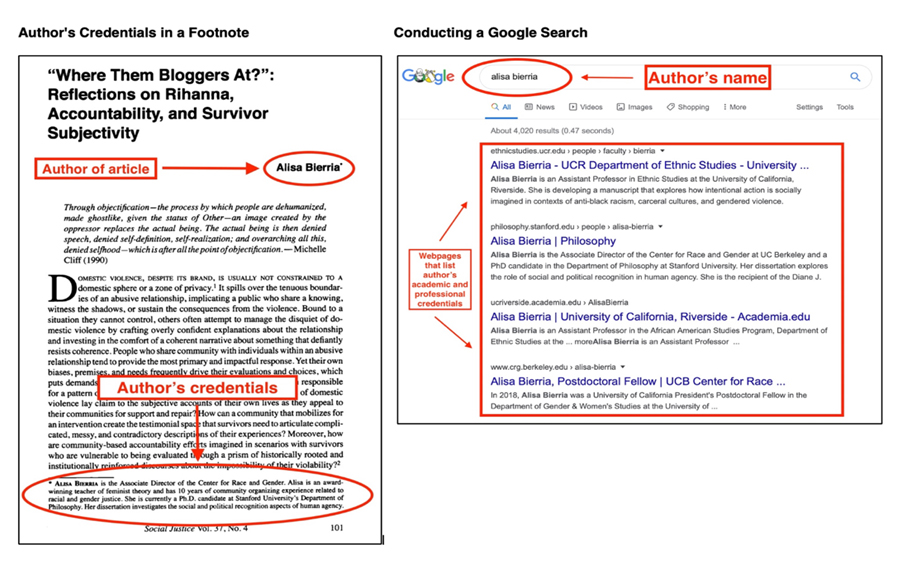
Sometimes, students forgo referencing the author’s credentials and, instead, reference the journal in which the article is published. For instance, students may say:
Example
𝐁𝐫𝐚𝐧𝐝𝐚𝐥𝐞 𝐌𝐢𝐥𝐥𝐬 𝐨𝐟 𝐭𝐡𝐞 𝙃𝙤𝙬𝙖𝙧𝙙 𝙅𝙤𝙪𝙧𝙣𝙖𝙡 𝙤𝙛 𝘾𝙤𝙢𝙢𝙪𝙣𝙞𝙘𝙖𝙩𝙞𝙤𝙣𝙨 𝐚𝐫𝐠𝐮𝐞𝐬, “𝐁𝐥𝐚𝐜𝐤 𝐟𝐞𝐦𝐚𝐥𝐞 𝐟𝐢𝐥𝐦𝐦𝐚𝐤𝐞𝐫𝐬 𝐰𝐡𝐨 𝐜𝐡𝐚𝐥𝐥𝐞𝐧𝐠𝐞 𝐦𝐢𝐬𝐫𝐞𝐩𝐫𝐞𝐬𝐞𝐧𝐭𝐚𝐭𝐢𝐨𝐧𝐬 𝐨𝐟 𝐁𝐥𝐚𝐜𝐤 𝐰𝐨𝐦𝐞𝐧 𝐬𝐞𝐞𝐤 𝐭𝐨 𝐜𝐞𝐥𝐞𝐛𝐫𝐚𝐭𝐞 𝐁𝐥𝐚𝐜𝐤𝐧𝐞𝐬𝐬 𝐚𝐧𝐝 𝐰𝐨𝐦𝐚𝐧𝐡𝐨𝐨𝐝” (𝟒).What’s the problem here? Well, Brandale Mills does not belong to, nor work for, the 𝘏𝘰𝘸𝘢𝘳𝘥 𝘑𝘰𝘶𝘳𝘯𝘢𝘭 𝘰𝘧 𝘊𝘰𝘮𝘮𝘶𝘯𝘪𝘤𝘢𝘵𝘪𝘰𝘯𝘴. Rather, a journal is a form of publication in which academics and scholars can publish their research. Most scholars have their work published in several different journals, and anyone can submit an article to a journal (i.e., if their article aligns with the journal’s field of study). Once a scholar submits an article, it’s peer-reviewed by other scholars and either rejected or accepted for publication.
Ultimately, it’s more important to reference the author’s background as opposed to the journal where the article is published. If your reader really wants to know where the article is published, they can find this information on your Works Cited page.
Using a Colon
Let’s look at another formatting option for quotes: the colon.
You can introduce a quote with an independent clause (i.e., a clause that can stand alone as a complete sentence) followed by a colon. Let’s look at some examples:
Examples
𝐓𝐚𝐲𝐥𝐨𝐫 𝐉𝐞𝐧𝐤𝐢𝐧𝐬 𝐑𝐞𝐢𝐝’𝐬 𝐧𝐨𝐯𝐞𝐥, 𝙏𝙝𝙚 𝙎𝙚𝙫𝙚𝙣 𝙃𝙪𝙨𝙗𝙖𝙣𝙙𝙨 𝙤𝙛 𝙀𝙫𝙚𝙡𝙮𝙣 𝙃𝙪𝙜𝙤, 𝐞𝐱𝐩𝐥𝐨𝐫𝐞𝐬 𝐭𝐡𝐞 𝐢𝐬𝐬𝐮𝐞 𝐨𝐟 𝐝𝐨𝐦𝐞𝐬𝐭𝐢𝐜 𝐚𝐛𝐮𝐬𝐞 𝐟𝐫𝐨𝐦 𝐭𝐡𝐞 𝐩𝐞𝐫𝐬𝐩𝐞𝐜𝐭𝐢𝐯𝐞 𝐨𝐟 𝐭𝐡𝐞 𝐯𝐢𝐜𝐭𝐢𝐦: “𝐁𝐮𝐭 𝐭𝐡𝐞𝐧 𝐲𝐨𝐮 𝐭𝐞𝐥𝐥 𝐡𝐢𝐦 𝐲𝐨𝐮’𝐫𝐞 𝐧𝐨𝐭 𝐬𝐮𝐫𝐞 𝐲𝐨𝐮 𝐞𝐯𝐞𝐫 𝐰𝐚𝐧𝐭 𝐚 𝐟𝐚𝐦𝐢𝐥𝐲, 𝐚𝐧𝐝 𝐡𝐞 𝐡𝐢𝐭𝐬 𝐲𝐨𝐮 𝐨𝐧𝐜𝐞 𝐦𝐨𝐫𝐞. 𝐘𝐨𝐮 𝐭𝐞𝐥𝐥 𝐲𝐨𝐮𝐫𝐬𝐞𝐥𝐟 𝐢𝐭’𝐬 𝐮𝐧𝐝𝐞𝐫𝐬𝐭𝐚𝐧𝐝𝐚𝐛𝐥𝐞, 𝐰𝐡𝐚𝐭 𝐡𝐞 𝐝𝐢𝐝” (𝟖𝟏).
𝐏𝐫𝐢𝐬𝐜𝐢𝐥𝐥𝐚 𝐏𝐞ñ𝐚 𝐎𝐯𝐚𝐥𝐥𝐞, 𝐚 𝐩𝐫𝐨𝐟𝐞𝐬𝐬𝐨𝐫 𝐨𝐟 𝐅𝐢𝐥𝐦 𝐚𝐧𝐝 𝐌𝐞𝐝𝐢𝐚 𝐒𝐭𝐮𝐝𝐢𝐞𝐬 𝐚𝐭 𝐭𝐡𝐞 𝐔𝐧𝐢𝐯𝐞𝐫𝐬𝐢𝐭𝐲 𝐨𝐟 𝐎𝐫𝐞𝐠𝐨𝐧, 𝐜𝐡𝐚𝐫𝐚𝐜𝐭𝐞𝐫𝐢𝐳𝐞𝐬 𝐑𝐢𝐭𝐚 𝐇𝐚𝐲𝐰𝐨𝐫𝐭𝐡’𝐬 𝐡𝐚𝐢𝐫 𝐭𝐫𝐚𝐧𝐬𝐟𝐨𝐫𝐦𝐚𝐭𝐢𝐨𝐧 𝐚𝐬 𝐚 𝐦𝐚𝐣𝐨𝐫 𝐭𝐮𝐫𝐧𝐢𝐧𝐠 𝐩𝐨𝐢𝐧𝐭 𝐢𝐧 𝐭𝐡𝐞 𝐚𝐜𝐭𝐫𝐞𝐬𝐬’ 𝐜𝐚𝐫𝐞𝐞𝐫: “𝐈𝐧 𝐛𝐞𝐭𝐰𝐞𝐞𝐧 𝐛𝐥𝐨𝐧𝐝 (𝐰𝐡𝐢𝐭𝐞) 𝐚𝐧𝐝 𝐫𝐚𝐯𝐞𝐧-𝐡𝐚𝐢𝐫𝐞𝐝 (𝐧𝐨𝐧𝐰𝐡𝐢𝐭𝐞), 𝐇𝐚𝐲𝐰𝐨𝐫𝐭𝐡’𝐬 𝐧𝐞𝐰𝐥𝐲 𝐝𝐲𝐞𝐝 𝐫𝐞𝐝 𝐡𝐚𝐢𝐫 𝐡𝐞𝐥𝐩𝐞𝐝 ‘𝐛𝐫𝐢𝐠𝐡𝐭𝐞𝐧’ 𝐨𝐫 𝐫𝐚𝐜𝐢𝐚𝐥𝐥𝐲 𝐦𝐨𝐛𝐢𝐥𝐢𝐳𝐞 𝐡𝐞𝐫 𝐢𝐦𝐚𝐠𝐞 𝐭𝐨𝐰𝐚𝐫𝐝 𝐰𝐡𝐢𝐭𝐞𝐧𝐞𝐬𝐬 𝐰𝐡𝐢𝐥𝐞 𝐫𝐞𝐭𝐚𝐢𝐧𝐢𝐧𝐠 𝐭𝐡𝐞 𝐚𝐦𝐛𝐢𝐠𝐮𝐢𝐭𝐲 𝐨𝐟 𝐡𝐞𝐫 𝐩𝐚𝐬𝐭 𝐭𝐡𝐫𝐨𝐮𝐠𝐡 𝐞𝐭𝐡𝐧𝐢𝐜 𝐜𝐡𝐚𝐫𝐚𝐜𝐭𝐞𝐫𝐢𝐳𝐚𝐭𝐢𝐨𝐧 𝐚𝐧𝐝 𝐞𝐱𝐨𝐭𝐢𝐜 𝐥𝐨𝐜𝐚𝐥𝐞𝐬” (𝟕𝟖).
In these examples, a colon is used to separate an independent clause from a related quote. For instance, in the first example, the independent clause, “𝐓𝐚𝐲𝐥𝐨𝐫 𝐉𝐞𝐧𝐤𝐢𝐧𝐬 𝐑𝐞𝐢𝐝’𝐬 𝐧𝐨𝐯𝐞𝐥, 𝙏𝙝𝙚 𝙎𝙚𝙫𝙚𝙣 𝙃𝙪𝙨𝙗𝙖𝙣𝙙𝙨 𝙤𝙛 𝙀𝙫𝙚𝙡𝙮𝙣 𝙃𝙪𝙜𝙤, 𝐞𝐱𝐩𝐥𝐨𝐫𝐞𝐬 𝐭𝐡𝐞 𝐢𝐬𝐬𝐮𝐞 𝐨𝐟 𝐝𝐨𝐦𝐞𝐬𝐭𝐢𝐜 𝐚𝐛𝐮𝐬𝐞 𝐟𝐫𝐨𝐦 𝐭𝐡𝐞 𝐩𝐞𝐫𝐬𝐩𝐞𝐜𝐭𝐢𝐯𝐞 𝐨𝐟 𝐭𝐡𝐞 𝐯𝐢𝐜𝐭𝐢𝐦,” could – grammatically speaking – stand alone as a complete sentence. However, we want to support our claim with direct evidence (i.e., a quote), so we add a colon to separate the independent clause from the quote.
But how can you easily determine when to use a comma or a colon to introduce a quote? The easiest way to do this is by looking at the word that comes directly before the quote. Use a comma after a verb (e.g., says, explains, asks, reflects) and a colon after a noun (e.g., victim, career).
Let’s try an example!
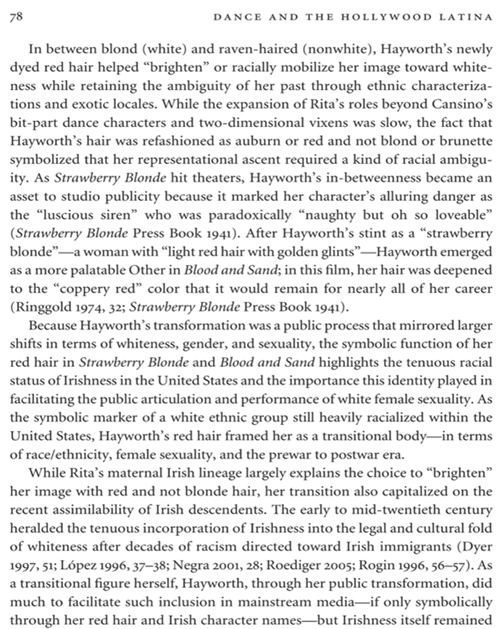
Making the Quote Part of Your Own Sentence
(Without Using a Comma or Colon)
Next, let’s briefly talk about how you can integrate a quote into your own sentence without using a comma or colon. This is pretty easy, so let’s start by looking at some examples:
Examples
𝐓𝐡𝐞 𝐦𝐞𝐝𝐢𝐚 𝐝𝐞𝐬𝐜𝐫𝐢𝐛𝐞𝐬 𝐄𝐯𝐞𝐥𝐲𝐧 𝐇𝐮𝐠𝐨 𝐚𝐬 𝐚 𝐥𝐨𝐯𝐞𝐥𝐞𝐬𝐬 𝐰𝐢𝐟𝐞 𝐰𝐡𝐨 “𝐝𝐨𝐞𝐬𝐧’𝐭 𝐞𝐯𝐞𝐧 𝐚𝐭𝐭𝐞𝐦𝐩𝐭 𝐭𝐨 𝐤𝐞𝐞𝐩 𝐚 𝐜𝐥𝐞𝐚𝐧 𝐡𝐨𝐮𝐬𝐞 𝐨𝐫 𝐦𝐢𝐧𝐝 𝐡𝐞𝐫 𝐡𝐮𝐬𝐛𝐚𝐧𝐝’𝐬 𝐬𝐢𝐦𝐩𝐥𝐞 𝐫𝐞𝐪𝐮𝐞𝐬𝐭𝐬” (𝐉𝐞𝐧𝐤𝐢𝐧𝐬 𝐑𝐞𝐢𝐝 𝟗𝟗).
𝐈𝐧 𝐡𝐞𝐫 𝐡𝐢𝐬𝐭𝐨𝐫𝐢𝐜𝐚𝐥 𝐚𝐧𝐚𝐥𝐲𝐬𝐢𝐬 𝐨𝐟 𝐟𝐢𝐥𝐦 𝐝𝐮𝐫𝐢𝐧𝐠 𝐭𝐡𝐞 𝟏𝟗𝟎𝟑𝐬, 𝐄𝐦𝐢𝐥𝐲 𝐂𝐚𝐫𝐦𝐚𝐧, 𝐚 𝐩𝐫𝐨𝐟𝐞𝐬𝐬𝐨𝐫 𝐨𝐟 𝐅𝐢𝐥𝐦 𝐒𝐭𝐮𝐝𝐢𝐞𝐬 𝐚𝐭 𝐂𝐡𝐚𝐩𝐦𝐚𝐧 𝐔𝐧𝐢𝐯𝐞𝐫𝐬𝐢𝐭𝐲, 𝐚𝐫𝐠𝐮𝐞𝐬 𝐭𝐡𝐚𝐭 “𝐇𝐨𝐥𝐥𝐲𝐰𝐨𝐨𝐝 𝐫𝐞𝐚𝐥𝐥𝐲 𝐰𝐚𝐬 𝐦𝐨𝐫𝐞 𝐨𝐟 𝐚 ‘𝐰𝐨𝐦𝐚𝐧’𝐬 𝐭𝐨𝐰𝐧’ 𝐢𝐧 𝐭𝐡𝐚𝐭 𝐩𝐫𝐨𝐝𝐮𝐜𝐞𝐫𝐬 𝐝𝐞𝐬𝐢𝐠𝐧𝐞𝐝, 𝐩𝐫𝐨𝐝𝐮𝐜𝐞𝐝 𝐚𝐧𝐝 𝐦𝐚𝐫𝐤𝐞𝐭𝐞𝐝 𝐭𝐡𝐞𝐢𝐫 𝐟𝐢𝐥𝐦𝐬 𝐢𝐧 𝐨𝐫𝐝𝐞𝐫 𝐭𝐨 𝐜𝐚𝐩𝐭𝐮𝐫𝐞 𝐭𝐡𝐞 𝐟𝐞𝐦𝐚𝐥𝐞 𝐚𝐮𝐝𝐢𝐞𝐧𝐜𝐞” (𝟐𝟐).
𝐎𝐫𝐢𝐠𝐢𝐧𝐚𝐥𝐥𝐲, 𝐭𝐡𝐞 𝐜𝐨𝐧𝐜𝐞𝐩𝐭 𝐨𝐟 “𝐝𝐨𝐮𝐛𝐥𝐞 𝐣𝐞𝐨𝐩𝐚𝐫𝐝𝐲” 𝐫𝐞𝐟𝐞𝐫𝐫𝐞𝐝 𝐭𝐨 “𝐭𝐡𝐞 𝐜𝐨𝐦𝐛𝐢𝐧𝐞𝐝 𝐞𝐟𝐟𝐞𝐜𝐭𝐬 𝐨𝐟 𝐬𝐞𝐱𝐢𝐬𝐦 𝐚𝐧𝐝 𝐫𝐚𝐜𝐢𝐬𝐦 𝐨𝐧 𝐭𝐡𝐞 𝐞𝐱𝐩𝐞𝐫𝐢𝐞𝐧𝐜𝐞𝐬 𝐨𝐟 𝐛𝐥𝐚𝐜𝐤 𝐰𝐨𝐦𝐞𝐧 (𝐋𝐢𝐧𝐜𝐨𝐥𝐧 𝐚𝐧𝐝 𝐀𝐥𝐥𝐞𝐧 𝟔𝟏𝟒). 𝐒𝐢𝐧𝐜𝐞 𝐭𝐡𝐞𝐧, 𝐭𝐡𝐞 𝐜𝐨𝐧𝐜𝐞𝐩𝐭 𝐡𝐚𝐬 𝐛𝐞𝐞𝐧 𝐮𝐬𝐞𝐝 𝐭𝐨 𝐞𝐱𝐩𝐥𝐨𝐫𝐞 𝐭𝐡𝐞 𝐫𝐞𝐥𝐚𝐭𝐢𝐨𝐧𝐬𝐡𝐢𝐩 𝐛𝐞𝐭𝐰𝐞𝐞𝐧 𝐠𝐞𝐧𝐝𝐞𝐫 𝐚𝐧𝐝 𝐚𝐠𝐞. 𝐀𝐜𝐜𝐨𝐫𝐝𝐢𝐧𝐠 𝐭𝐨 𝐬𝐨𝐜𝐢𝐨𝐥𝐨𝐠𝐢𝐬𝐭𝐬 𝐀𝐧𝐧𝐞 𝐄. 𝐋𝐢𝐧𝐜𝐨𝐥𝐧 𝐚𝐧𝐝 𝐌𝐢𝐜𝐡𝐚𝐞𝐥 𝐏𝐚𝐭𝐫𝐢𝐜𝐤 𝐀𝐥𝐥𝐞𝐧, 𝐝𝐨𝐮𝐛𝐥𝐞 𝐣𝐞𝐨𝐩𝐚𝐫𝐝𝐲 “𝐩𝐮𝐭𝐬 𝐨𝐥𝐝𝐞𝐫 𝐰𝐨𝐦𝐞𝐧 𝐚𝐭 𝐚 𝐠𝐫𝐞𝐚𝐭𝐞𝐫 𝐝𝐢𝐬𝐚𝐝𝐯𝐚𝐧𝐭𝐚𝐠𝐞 𝐭𝐡𝐚𝐧 𝐭𝐡𝐞𝐢𝐫 𝐦𝐚𝐥𝐞 𝐜𝐨𝐮𝐧𝐭𝐞𝐫𝐩𝐚𝐫𝐭𝐬 𝐢𝐧 𝐚𝐥𝐥 𝐚𝐬𝐩𝐞𝐜𝐭𝐬 𝐨𝐟 𝐥𝐢𝐟𝐞, 𝐫𝐚𝐧𝐠𝐢𝐧𝐠 𝐟𝐫𝐨𝐦 𝐩𝐬𝐲𝐜𝐡𝐨𝐥𝐨𝐠𝐢𝐜𝐚𝐥 𝐩𝐫𝐨𝐛𝐥𝐞𝐦𝐬 𝐭𝐨 𝐞𝐜𝐨𝐧𝐨𝐦𝐢𝐜 𝐝𝐢𝐟𝐟𝐢𝐜𝐮𝐥𝐭𝐢𝐞𝐬” (𝟔𝟏𝟒).
As you can see from these examples, the quotes are not separated from the rest of the sentence; neither a comma nor a colon is used to introduce the quote. Rather, the sentence is worded in a way that allows it to seamlessly transition into the quote.
Let’s try an example!
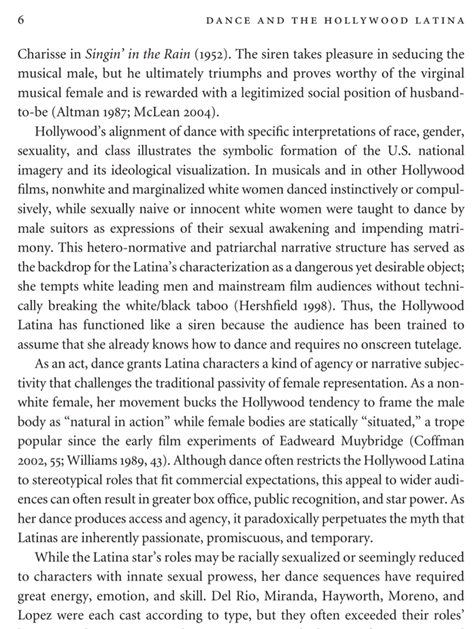
Quoting Quotes
What happens when you want to quote something that already contains quotation marks? There are two instances when you may run into this issue.
First, this issue may arise when you’re reading a scholarly article and the author of the article is quoting another scholar. See below for a specific example.
Scholar Quoting Another Scholar
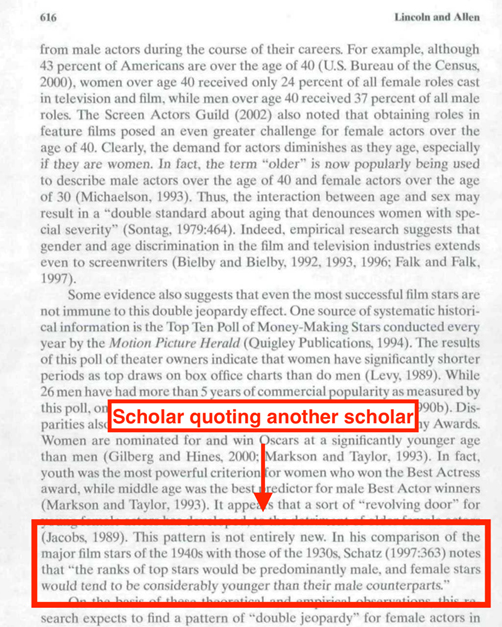
Let’s say we want to quote the exact quote that Lincoln and Allen are quoting in their article, “Double Jeopardy in Hollywood: Age and Gender in the Careers of Film Actors, 1926-1999.” One thing we could do is go to the original source (i.e., Schatz). Although this is the recommended path to take, let’s say our paper is due in a few hours and we don’t have time. If that’s the case, then we need to reference the original source (i.e., Schatz), 𝐚𝐧𝐝 we need to use a parenthetical citation to reference Lincoln and Allen. So, it should look like this:
Example
𝐓𝐡𝐨𝐦𝐚𝐬 𝐒𝐜𝐡𝐚𝐭𝐳, 𝐚 𝐩𝐫𝐨𝐟𝐞𝐬𝐬𝐨𝐫 𝐨𝐟 𝐟𝐢𝐥𝐦 𝐚𝐭 𝐭𝐡𝐞 𝐔𝐧𝐢𝐯𝐞𝐫𝐬𝐢𝐭𝐲 𝐨𝐟 𝐓𝐞𝐱𝐚𝐬 𝐚𝐭 𝐀𝐮𝐬𝐭𝐢𝐧, 𝐚𝐫𝐠𝐮𝐞𝐬 𝐭𝐡𝐚𝐭 “𝐭𝐡𝐞 𝐫𝐚𝐧𝐤𝐬 𝐨𝐟 𝐭𝐨𝐩 𝐬𝐭𝐚𝐫𝐬 𝐰𝐨𝐮𝐥𝐝 𝐛𝐞 𝐩𝐫𝐞𝐝𝐨𝐦𝐢𝐧𝐚𝐧𝐭𝐥𝐲 𝐦𝐚𝐥𝐞, 𝐚𝐧𝐝 𝐟𝐞𝐦𝐚𝐥𝐞 𝐬𝐭𝐚𝐫𝐬 𝐰𝐨𝐮𝐥𝐝 𝐭𝐞𝐧𝐝 𝐭𝐨 𝐛𝐞 𝐜𝐨𝐧𝐬𝐢𝐝𝐞𝐫𝐚𝐛𝐥𝐲 𝐲𝐨𝐮𝐧𝐠𝐞𝐫 𝐭𝐡𝐚𝐧 𝐭𝐡𝐞𝐢𝐫 𝐦𝐚𝐥𝐞 𝐜𝐨𝐮𝐧𝐭𝐞𝐫𝐩𝐚𝐫𝐭𝐬” (𝐪𝐭𝐝. 𝐢𝐧 𝐋𝐢𝐧𝐜𝐨𝐥𝐧 𝐚𝐧𝐝 𝐀𝐥𝐥𝐞𝐧 𝟔𝟏𝟔).In the above example, Thomas Schatz, the original source, is directly quoted; however, Lincoln and Allen are referenced in the parenthetical citation using “qtd. in” to signify that their article is the secondary source where we found the quote.
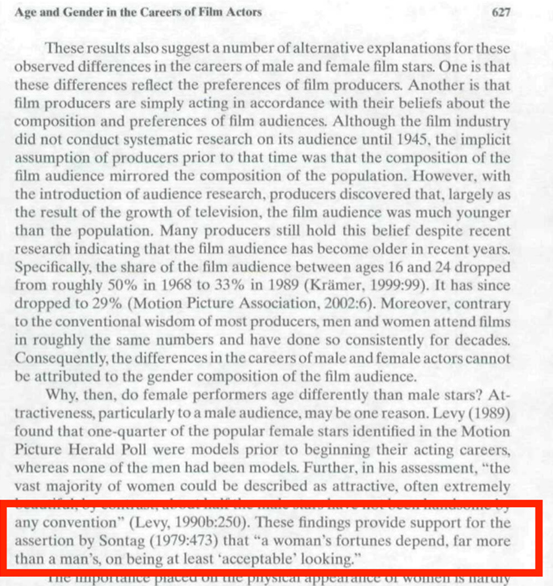
Quoting Dialogue
You may also need to quote a quote when you want to include a novel’s dialogue in your paper.
Let’s look at a page from 𝘛𝘩𝘦 𝘚𝘦𝘷𝘦𝘯 𝘏𝘶𝘴𝘣𝘢𝘯𝘥𝘴 𝘰𝘧 𝘌𝘷𝘦𝘭𝘺𝘯 𝘏𝘶𝘨𝘰 and practice quoting a line of dialogue.
Page from Evelyn Hugo
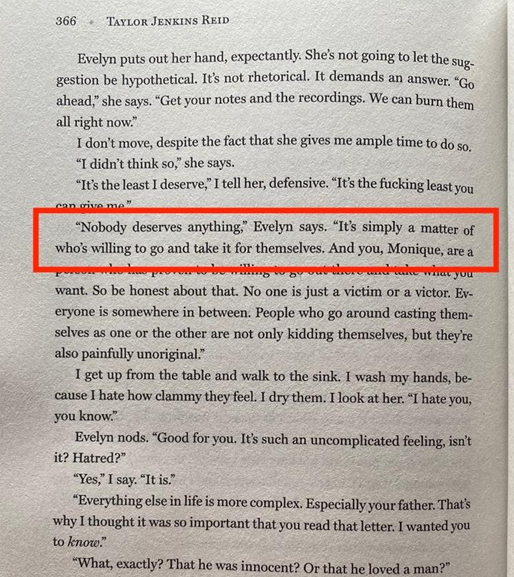
Quoting Dialogue from Evelyn Hugo
Suppose we want to include the highlighted quote in our paper. There are two ways we could do this.
1. If we just want to include a portion of the quote, we could say the following: 𝐈𝐧 𝙏𝙝𝙚 𝙎𝙚𝙫𝙚𝙣 𝙃𝙪𝙨𝙗𝙖𝙣𝙙𝙨 𝙤𝙛 𝙀𝙫𝙚𝙡𝙮𝙣 𝙃𝙪𝙜𝙤, 𝐄𝐯𝐞𝐥𝐲𝐧 𝐇𝐮𝐠𝐨 𝐭𝐞𝐥𝐥𝐬 𝐌𝐨𝐧𝐢𝐪𝐮𝐞, “𝐍𝐨𝐛𝐨𝐝𝐲 𝐝𝐞𝐬𝐞𝐫𝐯𝐞𝐬 𝐚𝐧𝐲𝐭𝐡𝐢𝐧𝐠” (𝐉𝐞𝐧𝐤𝐢𝐧𝐬 𝐑𝐞𝐢𝐝 𝟑𝟔𝟔).This tactic 𝐨𝐧𝐥𝐲 works if you want to include the character’s speech and nothing else from the text.
-
-
2. If we want to include more of the text (i.e., more than the character’s speech), we could say the following:
𝐈𝐧 𝙏𝙝𝙚 𝙎𝙚𝙫𝙚𝙣 𝙃𝙪𝙨𝙗𝙖𝙣𝙙𝙨 𝙤𝙛 𝙀𝙫𝙚𝙡𝙮𝙣 𝙃𝙪𝙜𝙤, 𝐄𝐯𝐞𝐥𝐲𝐧 𝐇𝐮𝐠𝐨 𝐬𝐡𝐚𝐫𝐞𝐬 𝐢𝐦𝐩𝐚𝐜𝐭𝐟𝐮𝐥 𝐥𝐢𝐟𝐞 𝐥𝐞𝐬𝐬𝐨𝐧𝐬 𝐰𝐢𝐭𝐡 𝐌𝐨𝐧𝐢𝐪𝐮𝐞: “‘𝐍𝐨𝐛𝐨𝐝𝐲 𝐝𝐞𝐬𝐞𝐫𝐯𝐞𝐬 𝐚𝐧𝐲𝐭𝐡𝐢𝐧𝐠,’ 𝐄𝐯𝐞𝐥𝐲𝐧 𝐬𝐚𝐲𝐬. ‘𝐈𝐭’𝐬 𝐬𝐢𝐦𝐩𝐥𝐲 𝐚 𝐦𝐚𝐭𝐭𝐞𝐫 𝐨𝐟 𝐰𝐡𝐨’𝐬 𝐰𝐢𝐥𝐥𝐢𝐧𝐠 𝐭𝐨 𝐠𝐨 𝐚𝐧𝐝 𝐭𝐚𝐤𝐞 𝐢𝐭 𝐟𝐨𝐫 𝐭𝐡𝐞𝐦𝐬𝐞𝐥𝐯𝐞𝐬'” (𝐉𝐞𝐧𝐤𝐢𝐧𝐬 𝐑𝐞𝐢𝐝 𝟑𝟔𝟔).
Since we included more than the character’s speech (in this case, we included “Evelyn says”), we must use single quotation marks around the character’s speech and double quotation marks around the entire portion of text we included.
Block Quotes
Let’s briefly go over MLA’s rules regarding long quotations.
So far, we’ve talked about how to format short quotes, which are quotes that do not exceed four lines in a paper. Long quotes, on the other hand, are more than four lines and thus need to be formatted as block quotes. Look at the example below.
How to Format a Block Quote
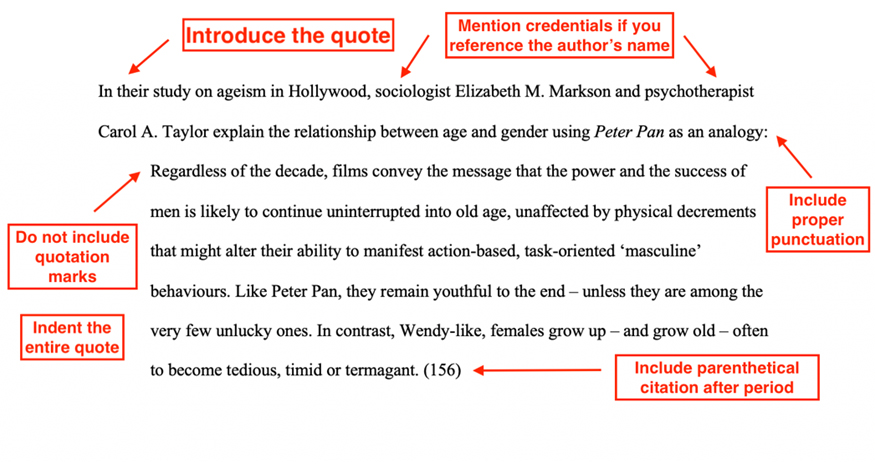
Regarding the Example
As you can see, the above quote is longer than four lines and thus follows the formatting rules for block quotes. Like short quotes, you still want to provide an introduction and include proper punctuation before the quote. However, unlike short quotes, you want to avoid using quotation marks, indent the entire quote, and place the parenthetical citation after the period.
Note: Until you’ve memorized how to format a block quote, consider taking a screenshot of the example. That way, you have easy access to a set of straightforward instructions when you’re incorporating a quote that exceeds four lines.
